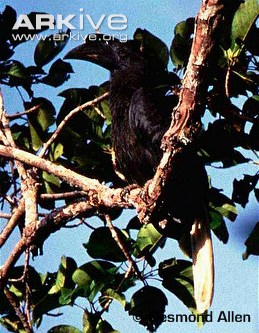| Citation |
|
Description |
Geographic Range [top]
Range Description: This species is endemic to three islands in the Sulu archipelago in the Philippines. Described as common to abundant in the late 19th century, it has undergone a drastic decline, and persists with certainty only on Tawi-tawi. Recent evidence suggests that its population is extremely low, perhaps numbering fewer than 20 pairs in the main mountain range. During a visit in February and June 2009, four individuals were reported in contiguous areas over two days on Tawi-tawi (I. Sarenas in litt. 2010). An estimated 250-300 km2 of forest remained on Tawi-tawi in 2001, although much of this included selectively logged forest (Mallari et al. 2001), and further declines have been noted since. Fortunately, the rate of clearance for oil palm plantations is lower than was feared previously. The species is thought to be extinct on Jolo (Sulu), but this requires confirmation. It is almost certainly extinct on Sanga-sanga. Local reports from 1995 suggested that it may visit the small islands of Tandubatu, Dundangan and Baliungan, though these hold very little primary forest (D. Allen in litt. 2012) and are unlikely to sustain resident populations.
Countries occurrence:
Native:
Philippines
Additional data:
? Estimated area of occupancy (AOO) - km2: 400 ? Continuing decline in area of occupancy (AOO): Yes
? Extreme fluctuations in area of occupancy (AOO): No ? Estimated extent of occurrence (EOO) - km2: 780
? Continuing decline in extent of occurrence (EOO): Yes ? Extreme fluctuations in extent of occurrence (EOO): No
? Number of Locations: 2-5 ? Continuing decline in number of locations: Yes
? Extreme fluctuations in the number of locations: No
Range Map: Click here to open the map viewer and explore range.
Population [top]
Population: The population is estimated to number a minimum of 40 individuals, equivalent to 27 mature individuals.
Trend Justification: Described as common to abundant in the late 19th century, this species is suspected to have undergone a very rapid decline over the last ten years, and persists with certainty only on Tawi-tawi. Here, extremely rapid conversion of habitat to oil palm plantations was predicted to cause near-total forest loss, but to date these predictions have not been vindicated.
Current Population Trend: Decreasing
Additional data:
? Number of mature individuals: 27 ? Continuing decline of mature individuals: Yes
? Extreme fluctuations: No ? Population severely fragmented: Yes
? No. of subpopulations: 1 ? Continuing decline in subpopulations: No
? Extreme fluctuations in subpopulations: No ? All individuals in one subpopulation: Yes
? No. of individuals in largest subpopulation: 100
Habitat and Ecology [top]
Habitat and Ecology: It inhabits primary dipterocarp forest, typically on mountain slopes (although this may simply reflect a constraint enforced by forest loss), occasionally visiting isolated fruiting trees over 1 km from the nearest forest. It requires large trees for nesting.
Systems: Terrestrial
Continuing decline in area, extent and/or quality of habitat: Yes
Generation Length (years): 9.2
Movement patterns: Not a Migrant
Threats [top]
Major Threat(s): Jolo (Sulu) and Sanga-sanga have apparently been almost completely deforested. By the mid-1990s, rapid clearance of primary forest on Tawi-tawi had rendered remaining lowland patches highly degraded, although plans to replace these with oil-palm plantations seem to have stalled, while the rate of logging has slowed with the remainder of forest being confined to rugged mountainous areas. Conversion to rubber plantations and mining activities remain a threat to existing forest (D. Allen in litt. 2012, 2016). There have been examples of known sites being cleared for agriculture (I. Sarenas in litt. 2010). High gun ownership in the recent past may have resulted in it being shot for food and target practice. Young may continue to be harvested for food, and the species may be collected for trade. Hunting pressure on Tawi-tawi may well have increased in recent years (I. Sarenas in litt. 2010).
Conservation Actions [top]
Conservation Actions: Conservation Actions Underway
CITES Appendix II. Military activity and insurgency continue to present a serious obstacle to conservation work in the Sulus. There are no formal protected areas in the archipelago. A proposal exists to provide conservation funding for the Tawi-tawi/Sulu Coastal Area, although neither the outcome nor the likely benefits to the species is known. A draft a municipal resolution for the banning of hunting or capture of Tawi-tawi endemics has been developed and was planned to be passed in July 2010 (I. Sarenas in litt. 2010).
Conservation Actions Proposed
Conduct surveys in all remaining forest patches in the Sulus to identify key sites. Urgently establish formal protected areas in the centre-west of Tawi-tawi to conserve populations in the main mountain range. Clarify the proposal for conservation funding for the Tawi-tawi/Sulu Coastal Area. Continue and expand environmental awareness programmes and establish captive-breeding populations for future supplementation/reintroduction.
Amended [top]
Amended reason: Added AOO value. Edited Threats Information text and added a threat. Also added a Facilitator/Compiler.
Citation: BirdLife International. 2017. Anthracoceros montani (amended version of 2016 assessment). The IUCN Red List of Threatened Species 2017: e.T22682447A117599120. http://dx.doi.org/10.2305/IUCN.UK.2017-3.RLTS.T22682447A117599120.en. Downloaded on 09 November 2018.
Disclaimer: To make use of this information, please check the .
Feedback: If you see any errors or have any questions or suggestions on what is shown on this page, please provide us with feedback so that we can correct or extend the information provided
|

